Design and Philosophy for an Interactive Media Creation.
Fibonacci Chimes: UW-Madison

About the Artwork
Fibonacci Chimes is a permanent installation for the Wisconsin Institutes for Discovery (WID) located at the University of Wisconsin Madison as a Wisconsin Percent for Art commission. The work is located in three main areas: (1) Three Interior Interactive Water Features, (2) Exterior Interactive Sound Sculpture, and (3) Exterior Interactive Water Feature. The installations are all interactive in that the light and sound media changes relative to the location and motion over the granite foot-stones at each of the artworks. Each day of the week a new piece is featured. The design of the works are based on the central concept of “the intersection of science and art.“
If given the power to name the human species, rather than homo sapien (knowing man) my choice would be exemplum peto, (pattern seekers). The very term homo sapien seems to imply a state of completion. Rather, I believe that humans are wired to constantly seek new patterns, and to seek new relationships and implications of those inter-related patterns. It seems appropriate then, that at the heart of the WID facility, where students, faculty, researchers, and others are seeking deeper and meaning of various integrated patterns within their fields and related fields, that this central thesis be applied to the facility artwork.
Fibonnaci Chimes
Fibonacci Chimes incorporates the Fibonacci sequence at the heart of the works. This pattern is one of many that exists in nature and is recognized and expressed in many of its manifestations such as mathematics, biology, art, music, architecture, computer science, etc. The sequence has been made popular with contemporary books and movies such as Dan Brown’s Da Vinci Code. Although the sequence has been given popular culture “mystical” status, my take is that it is but one of the many naturally occurring patterns that exists throughout our universe, and my appreciation is for its simple beauty and elegance.

The basic mathematical premise of the Fibonacci sequence can be overviewed by reading the Fibonacci sequence segment of this site, or by one of the thousands of web site links or books written on the subject since it was first presented in the book Liber Abaci in 1202 by Leonardo of Pisa, who was known as Fibonacci (a contraction of filius Bonacci, "son of Bonaccio"). But in brief it is a simple binary code comprised of the sum of the last two number in the sequence with the seed numbers of 0 and 1. Thus the sequence is: 0,1,1,2,3,5,8,13,21, etc.
Art and Sequence
As previously mentioned, the commissioned artwork uses the Fibonacci sequence as the primary means of inspiration for the entire project. The sequence has been used as a pattern by which to design the interactive lights and original music compositions that are triggered by the viewers of the work. As with all patterns, they can exist on two primary levels, the objective and subjective. The objective state is the pure “truth” of the element and exists without need of recognition or interpretation. The second state is the subjective, where its “meaning” is relative to the interpretation of the element.
All patterns seem to exist in three states: the objective, the subjective, and potentially the implied subjective. In other words, patterns exist (objective state); they might be recognized and subjectively interpreted, or they may not exist and patterns are supposed. I believe this is true with all things, and particularly with art. Some people simply do not see the patterns. Some strive to see the patterns and give them subjective meaning, while others apply meaning to events that may not include particular intended patterns. All three of these “states” have different purposes. It is the artistic goal of these works to present all three of these states. Many viewers of the work will simply not see, or try to see the patterns. Others will view the works and give subjective meaning to the patterns, while others will view the intended patterns and find others that were not intended by the artist.
Five Installations
Placed at each interactive installation site is a granite foot-stone that incorporates the Fibonacci Spiral that acts as the visual cue for interaction. When the viewer of the work passes over the top of the foot-stones, various light and sound events occur. The light and music patterns are all created using the basic relationships of the Fibonacci sequence. In fact, at the macro level, the project is designed using the first six digits of the sequence:
1, 2, 3, 5, 8, 13 (excluding 0 and 1).
(1) There is one thematically connected concept of works throughout the WID facility (2) There are two primary settings: indoors and outdoors . (3) There are three general locations of the works (A) Indoor Interactive Water Features, (B) Outdoor Interactive Sound Sculpture, and (C) Outdoor Interactive Water Feature . (5) There are five total installations 5.(8) The outdoor Sound Sculpture incorporates 8 sound trigger stations.

Incorporated Technology
The artworks incorporate the use of technology as part of each site. A camera is pointed toward each of the FIbonacci Spiral foot-stones; when motion and/or a particular color occurs, a designated “event” is triggered via a computer program written by the artist. Connected to the computers are video, audio, and DMX lines that control the sound and lights of each feature.
Each of the five stations have five different programs written for that particular media set. There are numerous variations on each of those five programs such that a unique program will be loaded on that installation for that particular day. Therefore, each day of the month features a unique content set for that installation. The works have been written using the “Update-able Canvas” approach, such that new works can be uploaded to the various stations for new interpretations. It is the hope of the artist that UW-Madison students will eventually create and upload new content to interpret the Fibonacci sequence.
Indoor Water Feature

There are three indoor water features that incorporate interactive lights and sound. The three indoor water features are located at the North Garden area on the main floor of the WID building. When the viewer of the work passes over the Fibonacci Spiral Foot-stone, sound and light sequences transpire and can be changed and controlled.
The water features have 48-feet of DMX-controlled LED RGB lights that are illuminated via Fibonacci patterns and are synchronized to Fibonacci-based music lines.
Each program features different pattern elements. The Fibonacci sequence is incorporated for sound in the following ways: dynamics, pitch, duration, timbre, scale pattern, and harmonic progression. Many of the music events are spontaneously generated by algorithms written by the artist, many are pre-composed lines that are triggered audio or MIDI events and are played by software synthesizers.
The light events use the Fibonacci sequence via mathematical ratios, sequences, and via the mathematical relationship of sound cycles to that of lightwave cycles.
Exterior Sound Sculpture


The south porch area of the WID building features the Fibonacci Chimes Sound Sculpture. Located throughout the space are eight granite foot-stones spaced between the five support pillars.
The Fibonacci Spirals foot-stones are etched to designate that particular ratio in the sequence. When the camera located above the foot-stones indicates motion and particular colors, events relative to the sequential ratio occurs.
For example, when one moves from the first to eight foot-stone, a musical “wake” of sound will emanate from each of the speakers located above the foot-stones. The “one” station will incorporate rhythms, pitches, durations, etc. relative to ratio of one, the “two” station will create rhythms, pitches, scale ratios, etc., relative to two, and so on. For example, if one moves from the “two” to the “three” stations, rhythms of “2 against 3” will sound, scale degrees relative to two and three will sound, and the mathematics and ratios of the Fibonacci sequence will be interpreted via sound. The sound sculpture can literally be played like a musical instrument by the viewer of the work by their choice of what stations to engage. The sound sculpture can be “played” by one, or many people simultaneously.
Exterior Water Feature

The exterior water feature installation is located by the main doors to the WID complex on the east-side of the facility.
As with all of the stations of the installation, the primary triggering means is via the motion over the granite Fibonacci Spiral foot-stones.
Located above the two stones (placed between the three support pillars) are cameras aimed down to the foot-stones.
The cameras are connected to a computer running a program written by the artist to control the submerged colored lights of the water feature and the two sound speakers located above the foot-stones.
Five main programs have been written with multiple various such that each day of the month features a unique work that will explore different variations of the Fibonacci sequence via light and sound/music patterns.
As with all the works, some of patterns will be obvious, others will be subtle and more difficult to detect. The overall goal is to create a work of art that changes in real time to the motion and location of the viewers to create sound and color light interactions that use the patterns of the Fibonacci sequence. That sequence can be perceived or not, but the goal is the ambient creation of sound of light that is both pleasant and curious.
My hope is that you will explore and “play” with the five installations to either discern the patterns, or ignore them, and/and simply enjoy the ambient light and sound created by your activation.
Cheers,
Kevin Dobbe
Patterns... Patterns... Patterns...
Patterns are within us, and surround us. Some of those patterns are obvious, some are imperceptible.
As mentioned on previous pages of this site, it is my contention that humans are “wired” to seek patterns. The very acquisition of knowledge, from my perspective, is the act of becoming aware of patterns and to organize them. Previously discovered patterns are “passed down” and the pattern seeker, or student, takes those patterns and builds a deeper set of interrelated complexes to formulate new meaning or application. Sometimes the patterns are sought out for the potential of new inter-relationships and applications, and sometimes they are sought out simply for the admiration of their beauty.
One pattern, the Fibonacci Sequence is a fascinating series and set of relationships that have numerous naturally occurring applications. The pattern seems to be used because of its efficiency, and I would argue, is appreciated because of its simplicity and elegance.
Although the series was recognized and applied in the metrical science (prosody) around 200 BCE in and around the region now know as India, the series in western culture was named after Leonardo of Pisa, who was known as Fibonacci (a contraction of filius Bonacci, "son of Bonaccio"). His book, Liber Abaci, introduced the mathematical sequence to western culture some fourteen centuries later in in 1202.

In brief, it is a simple binary code comprised of the sum of the last two number in the sequence with the seed numbers of 0 and 1. Thus the sequence is: 0,1,1,2,3,5,8,13,21, etc.

The sequence has a series of other related mathematical relationships such as the Golden Ratio, the Golden Spiral (closely related to the incorporated Fibonacci Spiral granite foot-stones).
The sequence can be seen to be applied in many fields including mathematics, biology, computer science, music, art, architecture, etc. The sequence has an efficiency that nature has adopted in many ways; from the packing of the seeds in sunflowers (which has two interwoven Fibonacci Spirals of 21 and 34 (F8 and F9); to the exterior pattern scales of the pineapple consisting of three hexagon of 5, 8, and 13 (F5, F6, and f7); to the growth pattern of most leaves where the phyllotaxis ratio is 5/8 (the ratio of leaves to revolution of the placement on the plant).
The sequence also has a relationship that is admired and incorporated into human
Music Fibonacci Patterns
"The heavenly motions... are nothing but a
continuous song for several voices,
perceived not by the ear but by the intellect,
a figured music which sets landmarks
in the immeasurable flow of time."
John Banville: Kepler, (Minerva 1990)

There is geometry in the humming of the strings
... there is music in the spacing of the spheres.
Pythagoras (582?-500? BC)
Music, a “time art”, is based upon patterns of time. The seven liberal arts, which was originally designed to educate the free citizen in the 5th century, incorporated music not only for aesthetic purposes, but as a means to demonstrate the patterns in mathematics, and indeed the universe.
Pythagoras discovered that the pitch of a musical note depends upon the length of the string which produces it. This allowed him to correlate the intervals of the musical scale with simple numerical ratios. When one plays a string stopped exactly half-way along its length an octave is produced. The octave has the same quality of sound as the note produced by the unstopped string but, as it vibrates at twice the frequency, it is heard at a higher pitch. The mathematical relationship between the keynote and its octave is expressed as a 'frequency ratio' of 1:2.
Musical scales have developed in different cultures over many centuries. It is curious that the very mathematical foundations of music selected by many cultures deeply incorporate the ratios of the Fibonacci sequence.

The table above demonstrates the relationship of the Fibonacci Sequence and the mathematical relationship of music notes (frequency of cycles/second), and notes incorporated into musical scales such as five (pentatonic), eight (diatonic), and thirteen notes (chromatic) scales.
The music content of Fibonacci Chimes is thematically related to the intersection of science and art, and in particular, the relationship of the mathematics of the Fibonacci Sequence and the mathematical ratios associated with music scales, intervals, melodic construction, and other music elements.
Some of the specific ways that these patterns have been incorporated into the various music elements of the installations are as follows:
(1) Fibonacci sequence scale (2) Fibonacci sequence math in the algorithms of spontaneous melodie (3) Fibonacci ratios of rhythms (4)Fibonacci ratios of dynamics (5) Fibonacci ratios of duration (6) Fibonacci ratios of pitch
Fibonacci Scale
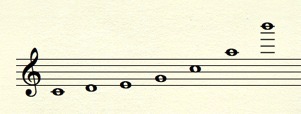
The octave (a mathematical ratio of 2:1) is a universally recognized pattern among all cultures. It is divided into different segments, or intervals, by various cultures. The primary scales incorporated in music of most cultures is the five (pentatonic), eight (diatonic), and thirteen notes (chromatic) scales. This might be coincidence, but my take is that the natural ratios that exist in the Fibonacci sequence is aesthetically interesting to humans simply because of the quality of the pattern. It is also curious that the primary notes used to build the basic triad is 1-3-5. The relationship of the Fibonacci sequence to the elements of music is indeed debatable, but for the purposes of this project, the sequence has been applied to all elements of the music composition components of the work.
For that reason, one of the primary scales used in this project is the Fibonacci sequence as applied to the western diatonic (8-note) scale. Based on a starting note (tonic) of C, the scale using 1,2,3,5,8,13,21 of Fibonacci sequence then is C, D, E, G, C, A, B.
This “Fibonacci Scale” has been used as one means by which to base the content around the Fibonacci patternOther scales have been created using the 13-notes (chromatic scale) and would then be C, C#, D, E, G, C, G#, and A (using 1,2,3,5,8,13,21,34 of Fibonacci sequence).
Fibonacci sequence math in the algorithms of spontaneous melodies
The program used by the artist to create Fibonacci Chimes is Max/MSP visual programming language. This programming language allows the user to create unique “code” that can be created to do anything the programmer can imagine given the parameters of the language.
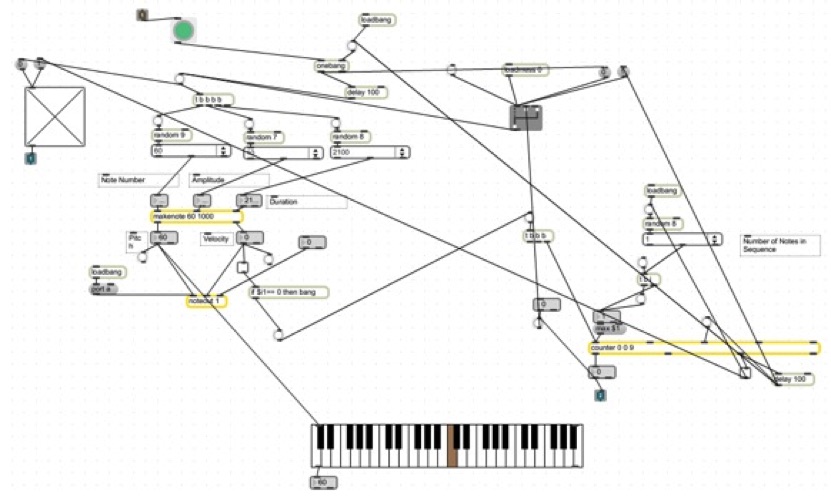
Incorporated throughout the various Fibonacci Chimes installations are the creation of melodies triggered by the viewer or the works. The melodies are comprised of: (1) pitch (note number), (2) duration (Length of sound in milliseconds), (3) amplitude (loudness), (4) timbre (instrument playing the sound). When the viewer of the work triggers events of the installation, the above elements are randomized using Fibonacci sequence numbers relative to pitch, duration, timbre, and intensity, thus creating melodies based solely upon Fibonacci-based mathematics.
Other occurring melodies have been improvised by the artists as MIDI files and are played by determined software synthesizers. The parameters of the improvisation were based upon scales and rhythmic events based upon the Fibonacci sequence.
Light Fibonacci Patterns
The light sequences that have been incorporated into the interior and exterior water feature elements of the Fibonacci Chimes installations are also based upon the mathematics of the golden spiral, golden ratio, and Fibonacci sequence. One of the ways that the Fibonacci sequence has been incorporated into the works has been through the mathematical relationship between light and sound.
Soundwaves are comprised of a compression/rarefaction wave, can create a pattern perceived as pitch. Over the Millennia, pitch has been assigned to corresponding notes relative to the numbers of compression/rarefaction cycles (currently 440 cycles per second is an “A”). As described above, Pythagoras related the ratio of 2:1 to the perception of the octave, therefore, all like-notes in any traditional musical scale (A’s, B’s, C’s, etc.) are all mathematical products of two.
The spectrum of lights that is visible to the human eye:
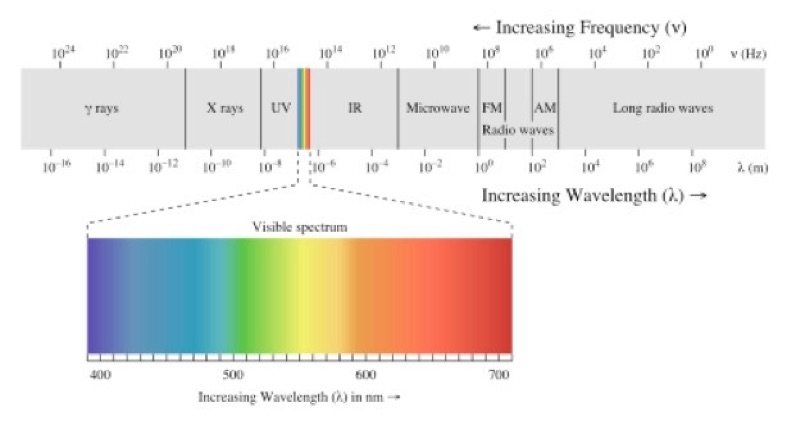
Light waves or electromagnetic radiation is measured in units called the angstrom. The visible spectrum of light extends from about 700 Å (red) to about 400 Å (violet).
The relationship of sound to light is done by comparing the frequency of sound (time) and the length of a light wave (space). This is done so because if we were to raise “middle C”, ( ~523 Hertz) by forty octaves (523 times 2 forty times), we would have a very high frequency of 575 trillion cycles per second. Therefore, light is measured by the length of the wave (space) rather than how many waves are occurring in a second (time). A higher frequency means that there are more waves occurring in a given amount of time, thus the waves become shorter as the frequency becomes higher.
To convert a frequency to wavelength, we divide the "speed of light" by the frequency. Thus, when we raise each pitch by forty octaves we find its corresponding color harmonic within the visible light spectrum. Below is a chart of the relationships of light to sound.
Technology
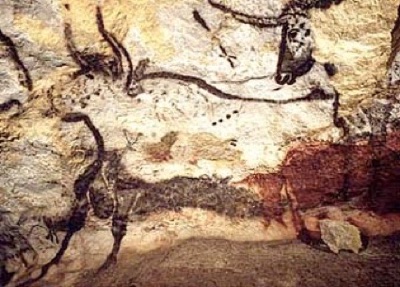
Since the first known works of art, “tools” have been at the center of realizing the ideas of the artist. New tools have been developed and made available to artists for Millennia. New paints, metallurgy, manufacturing advancements, etc., have all allowed artists to take advantage of these new “tools” and apply them for means to express ideas. The new tools of today are rapidly advancing and allow the contemporary artist new ways by which to express aesthetic statements and ideas.
Traditionally, the only means by which to create art was to be an active participant: a painter, a pianist, etc. All other experiences were passive: a viewer of the works hanging in museum, going to the opera, going to hear your favorite band, etc. The majority of arts participation has been primarily “passive”.
Contemporary tools are creating a paradigm shift in the arts. It is my view that the role of the “viewer” of the work is moving more toward the possibility of “participant”. The shift from traditional television to interactive games is one example of that shift from passive to active participant in the popular culture.
Interactive media is an emerging art-form that uses contemporary tools to allow the viewers of works to become active participants of those works. This is changing the way in which new artworks are conceived and designed. Most works have been linear; for example a traditional movie has a beginning, middle, and end as designed and created for the viewers by the artistic team. Music compositions are heard in a linear fashion from the beginning of the work to the end of the work. However, with the emergence of the new tools such as the computer, works can be designed to be non-linear. They can be experienced in a “hyper” mode... the viewer can change the order of the events, the content. The viewer can control if, when, and how the work “unfolds”.

The etymology of the term “Technology” derives from “tekhne” (art, craft). Therefore, the origins of the term was essentially the integration of art and science. It is within this sprit that Fibonacci Chimes has been created.
Tools
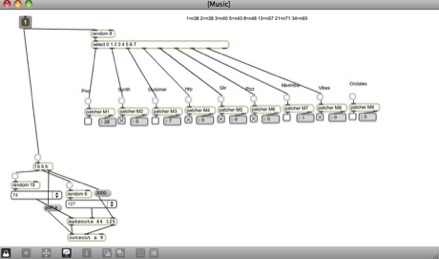
The central tool incorporated into all segments of the five Fibonacci Chimes installations is the computer.
Max/MSP a software programming language, is the means by which all the electronic elements of the work are controlled. A laser-etched granite foot-stone is embedded in the flooring by each of the works and act as visual cue points for interaction. Above each of the foot-stones are video cameras. The cameras pass along information regarding motion and color by those who move over the foot-stones. When motion and various color “trigger” the program, various light and sound events transpire.
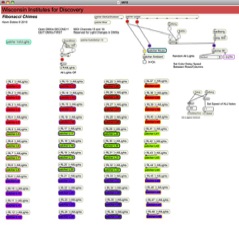
All of the events have been composed, designed, and created by the artists using the mathematics of the Fibonacci sequence.
The lights are controlled by using DMX light commands. The music events have been created using a music sequencer (in this case Logic) and exist as MIDI commands and/or files created by the artist.

When triggered, the commands and/or files are played via a software synthesizer (in this case, Main Stage).
Several thousand feet of video, audio, and DMX cable are connected to each of the five installations and are terminated in the lower level of the WID facility equipment room. They are then connected to the computer which are in turn connected to the audio amplifiers, speakers, and other light and sound hardware.
Indoor Interactive Water Features
The three indoor water features, located in the interior North Garden area includes interactive light and sound. The diagram to the right shows the basic hardware used to control the interactive lights and sound.
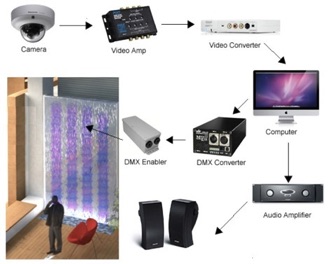
Outdoor Interactive Sound Sculpture
The outdoor interactive sound sculpture is located in the South Porch area are of the WID facility. The diagram to the right shows the basic hardware used to control the interactive sound.

Outdoor Interactive Water Feature
The outdoor interactive Water Feature is located in the South main entrance area a the the east end of the WID facility. The diagram below shows the basic hardware used to control the interactive sound and lights.

Kevin Dobbe
New Media Artist and Composer
